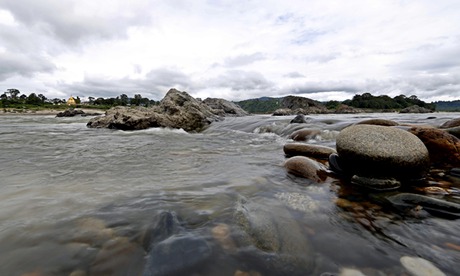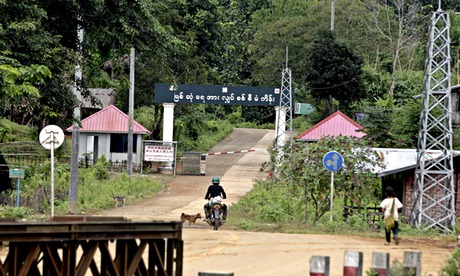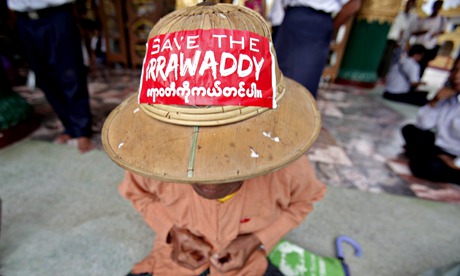Lapai Zoong kicks the red dirt outside his house and complains that nothing will grow. "The situation here is hopeless," he says. "In the old village we used to grow rice, fruit and vegetables. We were happy. Here they bulldozed the land and there's no soil. Everyone wants to go back to our old village."
But 70-year-old Lapai is not allowed back to his ancestral home just 12 miles to the north, even though the massive dam that was going to flood the village is now in limbo.
The Myitsone dam project lies unfinished in Kachin state, northern Burma, caught in a tug of war between the Burmese government and a powerful Chinese corporation. Lapai, along with 12,000 other Kachin villagers, remain in exile as a political and military drama plays out over the fate of the dam.
It was a project conceived, financed and – so far partially – built by the state-owned Chinese Power Investment Corporation (CPI), to take electricity across the border and help industrialise the Chinese province of Yunnan. At 152 metres high and with a potential capacity of 6,000 MW of electricity, the Myitsone was to be the largest of seven dams at the headwaters of the Irrawaddy River. If completed, it will be the 15th largest dam in the world. But soon after work started in 2009, the project ran into trouble.
Environmentalists objected because the Irrawaddy is Burma's most important water resource, supporting a thriving fishing industry, irrigating Burma's rice bowl, and supplying silt to the Irrawaddy delta. Even the authors of the CPI's own environmental impact assessment wrote that "there is no need for such a big dam", and recommended instead two smaller dams further upstream.

the Myitsone was to be the largest of seven dams at the headwaters of the Irrawaddy River. Photograph: Nyein Chan Naing/EPA
Ordinary Burmese objected because the Irrawaddy is the country's spiritual lifeblood, the subject of stories, songs and poems. With around 90% of the electricity from the dam going to China, the Burmese saw little benefit for themselves.
Finally, the people of Kachin state objected because the 296-square-mile reservoir would not only submerge 63 villages, it would also drown a sacred site at the confluence of the N'Mai and Mali rivers.
As work got underway, the Kachin Independence Army broke a 17-year-old ceasefire to attack the dam site. In 2010, 10 bombs exploded around the dam site, killing a Chinese worker.
Still the Burmese government pushed ahead with the project, keen to placate Burma's staunchest ally and biggest trading partner.
Then in 2011 Burma's new president, Thein Sein, abruptly announced a halt to construction, and promised that the dam would not be built during his term in office. It was a stunning turnaround that infuriated the Chinese.
Now fears are growing that this sleeping dragon at the head of the Irrawaddy will be revived when Thein Sein's term of office expires next year.
Because of military checkpoints that block off the dam site, the only way to get there is to turn off the paved road and onto a dirt road further west. The track weaves through the hills and tropical forests, emerging at Lapai's old village of Tang Hpre, now being reclaimed by the jungle. Wood and thatch houses are falling into disrepair. Orchards are choked by weeds, and trees drop fruit uselessly onto the ground.

Because of military checkpoints that block off the dam site, the only way to get there is to turn off the paved road and onto a dirt road further west. Photograph: Nyein Chan Naing/EPA
"People still sneak back," says Nonkai Dukon, the village pastor, pointing to a family hanging washing on a line in one garden. "Last year 22 people were arrested by the Burmese army for coming back here. But in order to live here again we have to repair a lot of damage to the village and clear the gardens. That's a barrier."
Through a clearing by the side of the dirt road there is a view onto the Irrawaddy and its steep, rocky eastern bank, showing evidence of past construction work. The cliffs had been terraced, and footings for the dam blasted into the hillside.
A few hundred metres upstream the dirt road ends at a headland overlooking the confluence of the N'Mai and Mali rivers, where they join to form the Irrawaddy. According to legend, this is the birthplace of the Kachin people. On the opposite side of the confluence a long concrete building that once housed Chinese construction workers and engineers lies abandoned.
The CPI is still committed to finishing the dam, and has launched a hearts-and-minds campaign to win support from the Kachin.

An activist wears a hat with the slogan 'Save The Irrawaddy'. Photograph: Nyein Chan Naing/EPA
"Representatives of CPI come here all the time, trying to convince us we are better off in this new village, and telling us how the electricity from the dam will benefit us," says Lapai. "But the electricity doesn't matter to people. What matters is our livelihood."
The environmental group Burma Rivers Network is worried that China will eventually get its way, as it has with so many other projects in Burma. "I think pressure from China will be too strong," says Ah Nan, a spokesperson for the group. But she adds that even if the project restarts the Chinese still face a problem. "It will be difficult to send material to the dam site, because they'll be sending it through a war zone. And this kind of development is only fuelling the conflict."
http://www.information.myanmaronlinecentre.com/burmese-villagers-exiled-from-ancestral-home-as-fate-of-dam-remains-unclear-2/
No comments:
Post a Comment